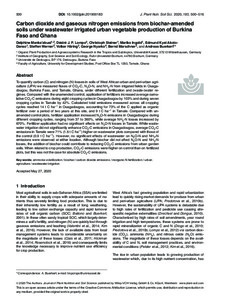Datum
2020-06-30Autor
Manka'abusi, DelphineLompo, Désiré Jean-PascalSteiner, ChristophIngold, MarikoAkoto-Danso, Edmund KyeiWerner, SteffenHäring, VolkerNyarko, GeorgeMarschner, BerndBuerkert, AndreasSchlagwort
630 Landwirtschaft, Veterinärmedizin AbwasserBewässerungswirtschaftBewässerungGemüsebauKohlendioxidAbgasBurkina FasoGhanaMetadata
Zur Langanzeige
Aufsatz

Carbon dioxide and gaseous nitrogen emissions from biochar‐amended soils under wastewater irrigated urban vegetable production of Burkina Faso and Ghana
Zusammenfassung
To quantify carbon (C) and nitrogen (N) losses in soils of West African urban and peri‐urban agriculture (UPA) we measured fluxes of CO₂‐C, N₂O‐N, and NH₃‐N from irrigated fields in Ouagadougou, Burkina Faso, and Tamale, Ghana, under different fertilization and (waste‐)water regimes. Compared with the unamended control, application of fertilizers increased average cumulative CO₂‐C emissions during eight cropping cycles in Ouagadougou by 103% and during seven cropping cycles in Tamale by 42%. Calculated total emissions measured across all cropping cycles reached 14 t C ha⁻¹ in Ouagadougou, accounting for 73% of the C applied as organic fertilizer over a period of two years at this site, and 9 t C ha⁻¹ in Tamale. Compared with unamended control plots, fertilizer application increased N₂O‐N emissions in Ouagadougou during different cropping cycles, ranging from 37 to 360%, while average NH₃‐N losses increased by 670%. Fertilizer application had no significant effects on N₂O‐N losses in Tamale. While wastewater irrigation did not significantly enhance CO₂‐C emissions in Ouagadougou, average CO₂‐C emissions in Tamale were 71% (1.6 t C ha⁻¹) higher on wastewater plots compared with those of the control (0.9 t C ha⁻¹). However, no significant effects of wastewater on N₂O‐N and NH₃‐N emissions were observed at either location. Although biochar did not affect N₂O‐N and NH₃‐N losses, the addition of biochar could contribute to reducing CO₂‐C emissions from urban garden soils. When related to crop production, CO₂‐C emissions were higher on control than on fertilized plots, but this was not the case for absolute CO₂‐C emissions.
Zitierform
In: Journal of Plant Nutrition and Soil Science (JPNSS) Volume 183 / Issue 4 (2020-06-30) , S. 500-516 ; EISSN 1522-2624Förderhinweis
Gefördert im Rahmen des Projekts DEALZitieren
@article{doi:10.17170/kobra-202008121561,
author={Manka'abusi, Delphine and Lompo, Désiré Jean-Pascal and Steiner, Christoph and Ingold, Mariko and Akoto-Danso, Edmund Kyei and Werner, Steffen and Häring, Volker and Nyarko, George and Marschner, Bernd and Buerkert, Andreas},
title={Carbon dioxide and gaseous nitrogen emissions from biochar‐amended soils under wastewater irrigated urban vegetable production of Burkina Faso and Ghana},
journal={Journal of Plant Nutrition and Soil Science (JPNSS)},
year={2020}
}
0500 Oax
0501 Text $btxt$2rdacontent
0502 Computermedien $bc$2rdacarrier
1100 2020$n2020
1500 1/eng
2050 ##0##http://hdl.handle.net/123456789/11695
3000 Manka'abusi, Delphine
3010 Lompo, Désiré Jean-Pascal
3010 Steiner, Christoph
3010 Ingold, Mariko
3010 Akoto-Danso, Edmund Kyei
3010 Werner, Steffen
3010 Häring, Volker
3010 Nyarko, George
3010 Marschner, Bernd
3010 Buerkert, Andreas
4000 Carbon dioxide and gaseous nitrogen emissions from biochar‐amended soils under wastewater irrigated urban vegetable production of Burkina Faso and Ghana / Manka'abusi, Delphine
4030
4060 Online-Ressource
4085 ##0##=u http://nbn-resolving.de/http://hdl.handle.net/123456789/11695=x R
4204 \$dAufsatz
4170
5550 {{Abwasser}}
5550 {{Bewässerungswirtschaft}}
5550 {{Bewässerung}}
5550 {{Gemüsebau}}
5550 {{Kohlendioxid}}
5550 {{Abgas}}
5550 {{Burkina Faso}}
5550 {{Ghana}}
7136 ##0##http://hdl.handle.net/123456789/11695
<resource xsi:schemaLocation="http://datacite.org/schema/kernel-2.2 http://schema.datacite.org/meta/kernel-2.2/metadata.xsd"> 2020-08-17T09:10:47Z 2020-08-17T09:10:47Z 2020-06-30 doi:10.17170/kobra-202008121561 http://hdl.handle.net/123456789/11695 Gefördert im Rahmen des Projekts DEAL eng Namensnennung 4.0 International http://creativecommons.org/licenses/by/4.0/ ammonia volatilization biochar carbon dioxide emissions inorganic N fertilization urban agriculture waste irrigation 630 Carbon dioxide and gaseous nitrogen emissions from biochar‐amended soils under wastewater irrigated urban vegetable production of Burkina Faso and Ghana Aufsatz To quantify carbon (C) and nitrogen (N) losses in soils of West African urban and peri‐urban agriculture (UPA) we measured fluxes of CO₂‐C, N₂O‐N, and NH₃‐N from irrigated fields in Ouagadougou, Burkina Faso, and Tamale, Ghana, under different fertilization and (waste‐)water regimes. Compared with the unamended control, application of fertilizers increased average cumulative CO₂‐C emissions during eight cropping cycles in Ouagadougou by 103% and during seven cropping cycles in Tamale by 42%. Calculated total emissions measured across all cropping cycles reached 14 t C ha⁻¹ in Ouagadougou, accounting for 73% of the C applied as organic fertilizer over a period of two years at this site, and 9 t C ha⁻¹ in Tamale. Compared with unamended control plots, fertilizer application increased N₂O‐N emissions in Ouagadougou during different cropping cycles, ranging from 37 to 360%, while average NH₃‐N losses increased by 670%. Fertilizer application had no significant effects on N₂O‐N losses in Tamale. While wastewater irrigation did not significantly enhance CO₂‐C emissions in Ouagadougou, average CO₂‐C emissions in Tamale were 71% (1.6 t C ha⁻¹) higher on wastewater plots compared with those of the control (0.9 t C ha⁻¹). However, no significant effects of wastewater on N₂O‐N and NH₃‐N emissions were observed at either location. Although biochar did not affect N₂O‐N and NH₃‐N losses, the addition of biochar could contribute to reducing CO₂‐C emissions from urban garden soils. When related to crop production, CO₂‐C emissions were higher on control than on fertilized plots, but this was not the case for absolute CO₂‐C emissions. open access Manka'abusi, Delphine Lompo, Désiré Jean-Pascal Steiner, Christoph Ingold, Mariko Akoto-Danso, Edmund Kyei Werner, Steffen Häring, Volker Nyarko, George Marschner, Bernd Buerkert, Andreas doi:10.1002/jpln.201900183 Abwasser Bewässerungswirtschaft Bewässerung Gemüsebau Kohlendioxid Abgas Burkina Faso Ghana publishedVersion EISSN 1522-2624 Issue 4 Journal of Plant Nutrition and Soil Science (JPNSS) 500-516 Volume 183 false </resource>
Die folgenden Lizenzbestimmungen sind mit dieser Ressource verbunden:


